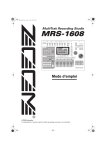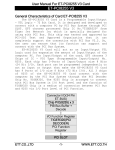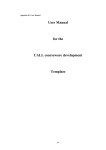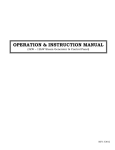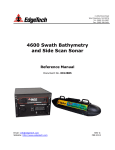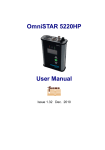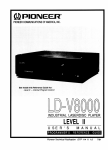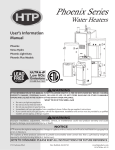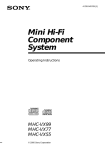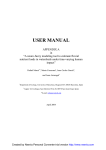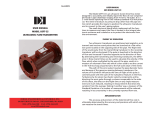Download DDA-1600 - BiddleMegger.com
Transcript
OPERATORS INSTRUCTION MANUAL For CIRCUIT BREAKER TEST SET MODEL DDA-1600 It is essential that this instruction book be read thoroughly by the operator of the test equipment before putting the equipment in service. Part No._ 50551 Rev. 1, 03/12/1998 Revision History Revision 0 1 ECN # Date 03/11/97 27999 03/12/98 IMPORTANT The information and data contained within this instruction manual are proprietary property of AVO International. The equipment described herein may be protected by one or more U.S. patents. AVO International specifically reserves to itself all rights to such proprietary information as well as all rights under any such patent, none of which is waived by the submission of this instruction manual. The recipient, if a Government agency, acknowledges that this instruction book and the equipment described were procured with "Limited Rights" to technical data as described in ASPR 9-203 (b). Copyright AVO International Inc. 1997 TABLE OF CONTENTS SECTION I .................................................................................................................................... 1 1. INTRODUCTION ................................................................................................... 1 A. GENERAL DESCRIPTION ........................................................................ 1 B. SPECIFICATIONS ..................................................................................... 2 SECTION II ................................................................................................................................... 4 1. DESCRIPTION of CONTROLS and INSTRUMENTATION................................... 4 A. GENERAL DESCRIPTION ........................................................................ 4 B. CONTROLS AND INSTRUMENTATION ................................................... 4 SECTION III .................................................................................................................................. 9 1. FRONT PANEL DISPLAY AND PROGRAMMING MENUS .................................. 9 2. Flow Diagram of Display Menus .......................................................................... 10 A. METERING DISPLAY.............................................................................. 10 B. MAIN MENU ............................................................................................ 10 C. LCD CONTRAST MENU ......................................................................... 11 D. SCR CONTROL MENU ........................................................................... 11 E. PULSE DURATION AND FIRING ANGLE MENUS ................................ 12 F. ACQUISITION CONTROL MENU ........................................................... 13 SECTION IV INPUT AND OUTPUT CIRCUITS .......................................................................... 14 1. INPUT: ................................................................................................................. 14 A. INPUT VOLTAGE .................................................................................... 14 B. INPUT LEADS ......................................................................................... 14 C. GROUNDING .......................................................................................... 14 D. SAFETY PRECAUTIONS ........................................................................ 14 SELECTION OF INPUT LEADS .............................................................. 14 A. SELECTION OF OUTPUT CONNECTIONS ........................................... 16 SERIES OR PARALLEL OUTPUT .......................................................... 16 SERIES CONNECTION .......................................................................... 17 PARALLEL CONNECTION ..................................................................... 18 C. DUTY RATINGS AND OVERLOAD CAPACITIES .................................. 19 DUTY CYCLES ON ............................................................................................ 19 TEST PROCEDURES AND TEST SET OPERATION ................................................................ 20 UNIT INTERCONNECTION ............................................................................................ 20 SECTION V ................................................................................................................................. 20 1. TEST PROCEDURES FOR TESTING OF MOTOR OVERLOAD RELAYS ....... 20 2. TEST PROCEDURE FOR TESTING OF MOLDED CASE AND LOW VOLTAGE POWER CIRCUIT BREAKERS ........................................................................... 24 3. MAINTENANCE OF PROTECTIVE APPARATUS MAINTENANCE OF MOTOR OVERLOAD RELAYS ......................................................................................... 28 4. MAINTENANCE OF MOLDED CASE CIRCUIT BREAKERS ............................. 31 5. MAINTENANCE OF LOW VOLTAGE POWER CIRCUIT BREAKERS ............... 33 6. SUGGESTED RECORD FORMS - INSPECTION AND TEST RESULTS ......... 35 SECTION VI ................................................................................................................................ 36 2. SERVICE DATA .................................................................................................. 37 SECTION VII. .............................................................................................................................. 39 1. SCHEMATIC DRAWING ..................................................................................... 39 i BULLETIN SECTION ISECTION I 1. INTRODUCTION. INTRODUCTION A. GENERAL DESCRIPTIONA. GENERAL DESCRIPTION 2 B. SPECIFICATIONSB. SPECIFICATIONS DDA-1600 Specifications Input DDA-1600 460 V 5%, 60 Hz, 150 A A variety of input power options, including 415 V/50 Hz, 380 V/50 Hz, are available. Output Output Current Model Number DDA-1600 Maximum Continuous Current Max. Amps Through an Air Frame Circuit Breaker Max. Amps Through a Molded Case Circuit Breaker 1,600 A 19,200 A 14,400 A Instrumentation Digital Ammeter Operating Mode Memory Continuous Digital Display 5 - digit display with 0.281 in (7 mm) numerals Ranges 200 / 2,000 / 20,000 / 200,000 A Accuracy Continuous - 1% of Reading Pulse (Peak) - 2% of Reading Pulse (RMS) - 1.5% of Reading Digital Timer Digital Display 5 - digit display with 0.281 in (7 mm) numerals Ranges 0.0001 to 99999 s 0.0001 to 99999 cycles Accuracy 1% of Reading for times that are 2 cycles and longer Digital Voltmeter Operating Mode Input Voltage Output Voltage External Voltage Digital Display 5 - digit display with 0.281 in (7 mm) numerals Ranges 600 V Accuracy 1% of Reading Dimensions and Weight 3 ModelNo. DDA-1600 Module Weight Dimensions lb kg H x W x D (in.) H x W x D (cm.) Control and Instrumentation 19 8.6 9.9 x 14.1 x 11.3 27 x 54 x 24.8 Power 100 45.4 14 x29 x 12.5 35.6 x 73.6 x 31.8 Output 210 95.4 7.5 x 33 x 45.7 19 x 83.8 x 45.7 4 SECTION IISECTION II 1. DESCRIPTION of CONTROLS and INSTRUMENTATION. DESCRIPTION of CONTROLS and INSTRUMENTATION A. GENERAL DESCRIPTIONA. GENERAL DESCRIPTION AVO International Circuit Breaker Test Sets are portable high current units designed for testing and adjusting low voltage circuit breakers and other current actuated devices. The units incorporate a variable high current ac output, and uses the latest in Digital Signal Processing (DSP) technology to control the circuit breaker test sets as well as measure the reactions of the breaker under test. The units are self protected against overloads and short circuits. B. CONTROLS AND INSTRUMENTATIONB. CONTROLS AND INSTRUMENTATION 1) OUTPUT CONTROLS: Adjustment of the output is accomplished by the combination of the OUTPUT SELECTOR Switch and VERNIER CONTROL. a) OUTPUT SELECTOR Switch: This is a multi-position switch which provides coarse adjustment of the output. Position 1 provides minimum output. The last position provides maximum output. The OUTPUT SELECTOR Switch is interlocked with the output initiating circuit. Depressing the switch to change positions operates the interlock and de-energizes the output and will not reenergize without pressing the START Button. b) VERNIER CONTROL (Power Stat): Provides fine adjustment of the output between steps of the OUTPUT SELECTOR Switch. 2. Circuit Breaker: Functions as the input POWER ON/OFF Switch and also provides short-circuit and overload protection. 3. FUSE: Protects control and isolation transformers 4. AUX. OUTLET A ground fault protected 120-volt outlet is provided for convenient connection of accessory equipment. 5. Input Receptacles Receptacles for input power connection. 6. Equipment Ground Test set chassis ground. For safety purposes, this should be connected to a power system ground . 5 Front View Reverse View 6 4. DDA CONTROL PANEL TEST 1. START Button - Energizes the output 2. STOP Button - De-energizes the output. 3. EXT. START Terminals - An external switch can be plugged into these terminals (blue) to provide remote initiation of the test set. TEST FUNCTION 4. TIMER STOP MODE - Three modes of operation are available to control the output and timer operation. C.A. (Current Actuate) - When the device to be tested has no contacts other than those involved in the passing of test current, this type of operation is used. In this position, the timer will run from the initiation of the test until the test circuit is interrupted. This position is the position most commonly used for controlling timer operations (Default setting). The output will de-energize when the current level drops below 8% of range. N.O. (Normally Open) - When it is desired to control the timer from a set of normally open contacts (such as an auxiliary contact) this type of operation may be used. In this position, the timer will run from the initiation of the test until the opening of the contacts connected to the TIMER STOP (Yellow) terminals. N.C. (Normally Closed) - When it is desired to control the timer from a set of normally closed contacts (such as a multi-pole circuit breaker), this type of operation may be used. In this position, the timer will run from the initiation of the test until the opening of the contact connected to the TIMER STOP (Yellow) terminals. 7 5. TIMER STOP Terminals - These terminals (yellow) facilitate connection to a set of contacts on the device under test to monitor contact opening and closure. The timer stops and output is de-energized when the device operates (used in conjunction with the TIMER STOP MODES of N.O. and N.C). 6. TIME UNITS Selection- Selects the mode of count; either cycles or seconds. 7. OUTPUT Mode - The following two selections are available PULSE - When selected, the output of the test set is on for a short, specified time period (default is 5 cycles) and then is turned off. (Should the device under test operate after pushing the START Button, the output will be de-energized). This position is normally used when setting the test current prior to the timing test and providing short high current pulses for instantaneous tests. However, the duration of this output pulse can be programmed via the Display Menu. (See the Section III, E. Front Panel Display and Programming Menus.) (Default Setting). MAINT. - When selected, and the START Button is pressed, the control circuit maintains the output of the test set until the device under test operates or the STOP Button is pressed. This is the normal position for Time Delay tests. VOLTS (voltmeter selection) Switches 8. VOLTS - three different selections are available for display IN - When this voltage display selection is made, the voltage at the input plugs of the test set will be displayed (Default Setting). OUT - When this voltage display selection is made, the voltage at the output terminals of the test set will be displayed. EXT. - When this voltage display selection is made, the voltage applied to the EXT. VOLTS terminals will be displayed. 9. EXT. VOLTS terminals - These two terminals enable the digital voltmeter to measure external a.c. voltages up to 600 Volts. AMMETER 10.AMMETER RANGE Switches - Selects the desired full scale range of the meter. NOTE: The output current level from the test set must be at least 8 percent of any full scale value before the ammeter will indicate an output reading. Please be aware that changing ammeter ranges while the output is energized may result in erroneous ammeter readings. The 4 range selections are 0.2kA/ 2kA/ 20kA / and 200 kA range. Default Setting is the 200 kA range. 11. AMMETER MODE MEM/CONT - Selects the mode of the ammeter circuit. In the MEM position, the highest measured current is indicated on the ammeter. The CONT mode permits the ammeter to continually indicate the value of output current. When in the CONT. and MAINT. Modes of operation, it will require 30 cycles of output current before a current value will be displayed. Default Setting is MeM. 8 SER/PAR - When operating the unit with the output in a series configuration, this switch must be in the SERIES position in order for the ammeter to read the correct amount of output current. (See Section IV, 2, A for more details.) The default setting is PARALLEL. FRONT PANEL DISPLAY AND INDICATORS 12. LCD Display Panel - This panel displays Output Amperage, Vac, and Time. It is also used to program many other features of the DDA control panel (See Section III, Front Panel Display and Programming Menus for more details). 13. Front Panel Indicators Over Range - Illuminates to indicate that output current has exceeded the RANGE selected. AMMETER Output Energized - Illuminates to indicate that the SCR has gated and the energized. output is Thermal Warning - Indicates that the thermal status of the test set is approaching an over temperature condition. Thermal Shutdown - Indicates that the thermal status of the test set has reached an over temperature condition. The test set will not operate as long as there is an over temperature condition. 14. Softkeys - Used to set programmable functions indicated on the LCD display panel. 9 SECTION IIISECTION III 1. FRONT PANEL DISPLAY AND PROGRAMMING MENUS. DISPLAY AND PROGRAMMING MENUS 2. Flow Diagram of Display Menus. Flow Diagram of Display Menus A. METERING DISPLAYA. METERING DISPLAY 10 FRONT PANEL All of the programmable menu options may be accessed by pressing the soft key underneath the word MENU in the metering display screen. When pressed, the following display will appear. B. MAIN MENUB. MAIN MENU From the MAIN MENU the user may select programming menus to make adjustments to the LCD display contrast, SCR controls, or Acquisition control (current calculation method). The user may also select to EXIT back out to the metering display screen. The desired option would be selected by pressing the soft key directly beneath that option. 11 C. LCD CONTRAST MENUC. LCD CONTRAST MENU The LCD CONTRAST MENU provides two options for optimizing a user s ability to view the display. Pressing the soft key directly beneath UP will cause the intensity of the display to be increased. Pressing the soft key directly beneath DOWN will cause the intensity of the display to be decreased. This menu also provides the option to return to the previous menu by pressing the soft key directly beneath EXIT. D. SCR CONTROL MENUD. SCR CONTROL MENU The SCR CONTROL MENU provides the ability to enter into two different areas of SCR adjustment. Pressing the soft key directly beneath PULSE DURATION will display a menu that will allow the user to program the number of cycles that the output of the test set will be energized during a momentary pulse. Pressing the soft key beneath FIRING ANGLE will display a menu that will allow the user to program the angle at which the output signal of the test set is initially energized. 12 E. PULSE DURATION AND FIRING ANGLE MENUS The PULSE DURATION MENU allows the user to program the number of cycles that the output of the test set will energized during a momentary pulse. The number of cycles can be increased or decreased by pressing the soft keys directly beneath UP or DOWN. Pressing the soft key beneath EXIT will return the user to the previous menu. The default pulse duration setting is 5 cycles. The FIRING ANGLE MENU allows the user to program the initial firing angle at which the output signal of the test set is energized. This is important when dealing with asymmetrical waveforms. The more inductive the test specimen, the more asymmetrical the output of the test set will be due to DC offset. Asymmetry in the output of the test set has become of increased importance when performing instantaneous trip tests on circuit breakers. By providing the ability to adjust the firing angle of the test set, the user can minimize the effect of DC offset and therefore collect more accurate information with regard to the instantaneous characteristics of the test specimen. See ACQUISITION CONTROL MENU for information on how to determine if the output of the test set is symmetrical and how to adjust the firing angle if it is not. The default firing angle is 70O. 13 F. ACQUISITION CONTROL MENUF. ACQUISITION CONTROL MENU The Acquisition Control MENU allows the user to select between two different current measurement methods. By pressing the softkey directly beneath either PEAK or RMS, the user selects which calculation will be used in displaying measured current on the metering display. PEAK measures the highest peak and multiplies it by a constant 0.707. This method of measurement should initially be compared to the RMS measurement method (with all output setting being the same), which is a true rms measurement. If the output waveform is symmetrical, the two measurements will be approximately the same current value. If these two measurements are not approximately the same value, adjust the firing angle in such a way as to bring the two measurements closer together. Although the PEAK and RMS measurement will never be the same value, the goal is to find the firing angle that will bring these two measurements as close together as possible in order to minimize DC offset. See FIRING ANGLE MENU for adjustment of firing angle. The method of current measurement is selected by pressing the soft key beneath the desired method. Pressing the softkey beneath EXIT will return the user to the previous menu. NOTE: The DDA controller will default to the PEAK Measurement Method. Most modern day trip units are RMS sensing devices. Therefore it is highly recommended that the Measurement Method be changed from PEAK to RMS upon powering up the test equipment. Because the majority of electronic trip units on circuit breakers manufactured today are RMS sensing, it is suggested to leave the DDA unit in RMS mode for most testing applications. However, some of the older styles of circuit breakers have peak sensing instantaneous trip elements. In these cases it would be desirable to select the PEAK Measurement Method in order to more closely model the current measurement method of the circuit breaker under test. 14 SECTION IV INPUT AND OUTPUT CIRCUITSSECTION IV INPUT AND OUTPUT CIRCUITS 1. INPUT:. INPUT A. INPUT VOLTAGEA. INPUT VOLTAGE: The AVO International Circuit Breaker Test Sets are designed to operate on a single phase voltage source. If the nominal rated voltage source is not available, or if use at various locations requires the capability to operate the test set from several different input voltages an optional input autotransformer may be used (see Sales Bulletin for description). B. INPUT LEADSB. INPUT LEADS: The AVO International Circuit Breaker Test Sets are designed to operate on a single phase voltage source. If the nominal rated voltage source is not available, or if use at various locations requires the capability to operate the test set from several different input voltages an optional input autotransformer may be used (see Sales Bulletin for description). NOTE: To achieve published output currents, the rated input voltage must be maintained at the test set terminals during the test. C. GROUNDINGC. GROUNDING: The AVO International Circuit Breaker Test Sets are designed to operate on a single phase voltage source. If the nominal rated voltage source is not available, or if use at various locations requires the capability to operate the test set from several different input voltages an optional input autotransformer may be used (see Sales Bulletin for description). D. SAFETY PRECAUTIONSD. SAFETY PRECAUTIONS: CAUTION For safety of the operator, it is absolutely essential that the test set be properly and effectively grounded. SELECTION OF INPUT LEADSSELECTION OF INPUT LEADS: When utilizing maximum output from the test set, the input line currents may be as high as 400% of nameplate rating. The following table has been prepared to aid in selecting the proper wire size for the input leads. To use the table, follow these four steps: 1. 2. 3. 4. Determine the rated input current from the nameplate on the test set. Be sure to choose the correct current for the input voltage being used. Multiply this value by four. Determine the length of input lead required. This is in circuit-feet, therefore it is the one-way distance from the test set to the power source. Select the proper wire size from the table using factors 2 and 3 above. 15 NOTE: For input currents exceeding 600 amperes, it is recommended that 2/0 cable be used and not exceed 50 feet in length. LENGTH OF INPUT LEADS DISTANCE FROM TEST SET TO POWER SOURCE FOUR TIMES (4X) RATED INPUT POWER 20 50 75 100 125 150 175 200 225 250 275 300 325 350 375 400 425 450 475 500 525 550 575 600 8 8 8 8 8 8 8 8 8 8 8 8 8 8 8 8 8 6 6 6 6 6 6 40 60 80 100 120 MINIMUM WIRE SIZE A.W.G. 8 8 8 8 8 8 8 8 6 6 6 6 4 4 4 4 4 4 4 2 2 2 2 8 8 8 8 8 6 6 6 4 4 4 4 2 2 2 2 2 2 2 1 1 1 1 8 8 8 6 6 4 4 4 4 2 2 2 2 2 1 1 1 1/0 1/0 1/0 1/0 2/0 2/0 16 8 8 6 6 4 4 4 2 2 2 2 1 1 1/0 1/0 1/0 2/0 2/0 2/0 2/0 8 8 6 4 4 2 2 2 2 1 1 1 1/0 2/0 2/0 2/0 140 FEET 8 6 4 4 2 2 2 1 1 1/0 1/0 2/0 2/0 2/0 The wire sizes in this chart will result in voltage drops of ten volts or less 2. OUTPUT: A. SELECTION OF OUTPUT CONNECTIONSA. SELECTION OF OUTPUT CONNECTIONS: Two output connections, parallel and series, provide various voltage and current ratings to adapt AVO International Circuit Breaker Test Sets to a wide variety of test circuit impedances. The test sets can be operated most efficiently by utilizing the parallel connection, which provides the HIGHEST CURRENT rating consistent with being able to obtain the desired test current. In this way, finer adjustment can be obtained by making maximum use of the variable autotransformer range. Even the smallest currents can be obtained from the parallel connection. The series connection should be used only when testing high impedance devices where the parallel connection does not have sufficient voltage to "push" the desired test current through the device. The operator should start with the parallel connection and move to the series connection only when necessary. To operate the test set in the parallel connection does not require any changes be made by the operator. However the test set in series requires that a special series bar be placed on the output bus to complete the series connection. SERIES OR PARALLEL OUTPUTSERIES OR PARALLEL OUTPUT: The test set can be used to provide either a 6 or a 12 volts. This is selected through the connection of the output bus. Refer to Figure #1 and Figure # 2 for output connections. The proper test set configuration must be selected to provide correct metering. 1. SERIES supplies double the voltage and half of the available output current. This is used to test breakers with high characteristic impedance. 2. PARALLEL supplies all of the current but half of the available output voltage. This is used to test breakers with low characteristic impedance. 17 Figure #1 SERIES CONNECTIONSERIES CONNECTION 1. Connect the S-Bar to output terminals 2 and 3. 2. Connect test cables to terminals 1 and 4. 1 2 S-Bar 3 4 18 Figure #2 PARALLEL CONNECTIONPARALLEL CONNECTION 1. Jumper output terminals 1 and 3 together and output terminals 2 and 4 together 2. Connect one test lead to the left side (terminals 1 and 3). Connect the other test lead to the right side (terminals 2 and 4). 1 2 3 4 The Stab Adapter Plates connect output terminals 1 and 3 and terminals 2 and 4 together for parallel operation. 19 C. DUTY RATINGS AND OVERLOAD CAPACITIESC. DUTY RATINGS AND OVERLOAD CAPACITIES: AVO International equipment is rated on a continuous duty basis as described by NEMA for test equipment in intermittent service; that is, 30 minutes ON followed by 30 minutes OFF. In other words, the equipment can supply rated output current for a maximum period of 30 minutes ON provided a 30 minute cooling OFF period follows. This is a satisfactory basis of rating for testing of circuit breakers and primary injection testing of relay and current transformers. When AVO International equipment is being used for heat runs on cables, busbars, terminations, etc., the 30 minute ON time will be exceeded. In such cases the output current should be limited to 70 percent of the rated output current and may be continued for an indefinite time. In addition to the continuous duty rating defined above, all units have considerable short-time overload capability. Duration of the overload is governed by thermal considerations within the test set. The maximum current available is determined essentially by the impedance of the load. The duty cycles of the CB-9110 and CB-9116 are as follows: DUTY CYCLES ON DUTY CYCLES ON DDA-1600 CIRCUIT BREAKER TEST SET (Current Rating Through Circuit Breaker) DDA-1600 CURRENT TIME ON TIME OFF 1,600 A 3,600 A 4,800 A 9,600 A 19,200 A Continuous 650 sec. 200 sec. 50 sec. 0.5 sec. N/A 60 min. 21 min. 35 min. 120 sec. THERMAL SET POINTS* Normal: 72o to 80oF Warning: 160 to 190oF Shutdown: 191 to 248oF *Temperature measured at output stabs adapter plates. 20 TEST PROCEDURES AND TEST SET OPERATIONTEST PROCEDURES AND TEST SET OPERATION UNIT INTERCONNECTIONUNIT INTERCONNECTION Use the following steps for interconnecting the unit. NOTE: When connecting to the power supply, always connect from load to source. 1. Insure that the supply power is off. 2. Connect all interconnecting cables. A. Connect the control cable from the Control and Instrumentation Section to the Power Section. B. Connect the metering cable from the Output Section to the Control and Instrumentation Section. C. Connect the ground Interconnect cable between the Power Section and the Output Section. D. Connect the power interconnect cable between the Power Section and the Output Section. 3. Ground the unit. 4. Connect the input power cables to the receptacles. NOTE: To achieve published output currents, the rated input voltage must be maintained at the test set terminals during the test. 5. Connect the power cables to an appropriate input power source. 21 SECTION VSECTION V 1. TEST PROCEDURES FOR TESTING OF MOTOR OVERLOAD RELAYS. PROCEDURES FOR TESTING OF MOTOR OVERLOAD RELAYS TEST Always refer to the manufacturer's literature applicable to the particular overload relay before testing. The test operator should be familiar with the operating characteristics of the relay, the tolerances applicable to the operating characteristics and any means of adjusting the relay. The test usually performed on these devices is to verify the time delay characteristics of the relay when subjected to an overload condition. One test point is usually suggested to establish whether the relay is operating correctly and within the band of the time-current curve for the relay. The suggested test current is three times (3x) the normal current rating of thermal overload relays or three times (3x) the pick-up current (setting) of magnetic overload relays. It is, of course, easiest to make the connections and perform the tests on the relays if they are removed from the starter. However, it is not necessary to remove the relay as long as the power circuit is de-energized and the test leads can be connected to the device. The high current leads from the test set to the relay under test should be kept as short as possible and should be twisted to minimize losses caused by inductive reactance. Run the test and note the time required for the overload relay to trip. If the tripping time exceeds the manufacturer s recommended value, or if the relay does not trip at all, the relay may not be protecting the motor properly. If the relay operates too quickly, it may result in unnecessary nuisance trips. It should be remembered that these devices operate over a wide band and precise results should not be sought. A tolerance of + 15% is usually acceptable for electromechanical devices. If a thermal overload relay is not operating properly, tripping too soon or too late, remove the heater element. Note its type, rating, etc., and compare with manufacturer's data for operating characteristics of the motor. If correct for the application, substitute a new heater of the same rating and retest. If either under- or over-sized heater elements are being used, replace with the proper size heater and retest. If a magnetic overload relay is not operating properly, refer to the relay manufacturer's literature for instructions on making adjustments of the time delay. If the relay is operating improperly, it also may be desirable to verify the pickup point (minimum operating point) of the relay. To perform this test, it is necessary to disengage the time delay feature of the overload relay. Refer to the manufacturer's literature for detailed instructions. 22 TESTING OF TIME DELAY: 1. Connect the test set to a suitable source of power. Be sure that the ON/OFF Switch on the test set is OFF. 2. Make sure the motor circuit is de-energized. 3. Connect the output of the test set to the terminal of the heater of operating coil to be tested. (See Section IV, 2, B - SELECTION OF OUTPUT CONNECTION). 4. Connect a set of light leads from the terminals marked TIMER STOP to the control circuit contacts of the relay being tested. 5. Turn test set's ON/OFF Switch "ON". The Control Panel Display should illuminate. 6. Set up of controls before testing: 7. In the Measurement Method menu, select the RMS method. CONTROL POSITION Circuit Breaker ON OUTPUT SELECTOR Switch 1 VERNIER CONTROL Zero (counterclockwise) OUTPUT MODE PULSE TIMER STOP MODE N.O. or N.C... Selection that is most appropriate for the TIMER STOP Contacts being used. Ammeter MODE MEMORY. Also set to Parallel or Series depending on output configuration. AMMETER RANGE So that test current can be read in the proper range of the ammeter VOLTMETER CIRCUIT Selection As desired, depending on voltage to be measured 23 8. Set the desired test current by rotation of the VERNIER CONTROL, and then pressing the START button per the following procedure. NOTE: Depending on the position of the OUTPUT SELECTOR Switch, the current may be increased by either clockwise or counter clockwise rotation of the VERNIER CONTROL (refer to chart of OUTPUT RANGES). For example, if the desired test current is 7500 amperes, the proper procedure would be to start with the OUTPUT SELECTOR Switch in position 1 and increase the VERNIER CONTROL from "0" toward "100". However, if the impedance of the device is such that you cannot get 7500 amperes at "100" on the VERNIER CONTROL with the tap selector on position 1 , switch the OUTPUT SELECTOR Switch to position number 2. On TAP position #2 the Black scaling is used to increase the output current. Rotate the VERNIER CONTROL counterclockwise toward "Black 100". If at full rotation of the VERNIER CONTROL, the desired current is not obtained, turn the OUTPUT SELECTOR Switch to the next higher position and repeat the procedure until the desired test current is reached. Since the PULSE OUTPUT MODE is selected, the output will only stay energized for programmed number of cycles (Default is 5 cycles. See PULSE DURATION MENU). The ammeter display will hold the reading of the amperage set. Continue until the desired current is achieved. If at the last position the desired test current is not reached, connect the output of the test set in series (See SELECTION OF OUTPUT CONNECTION, Section IV, 2, A.). Switch the Ammeter PARALLEL/SERIES Switch to the SERIES position, return the OUTPUT SELECTOR Switch to position 1 and repeat the above procedure until the desired current is achieved. 9. Select the MAINTAINED OUTPUT MODE . 10. elect the CONTINUOUS AMMETER MODE. 11. Wait several minutes to allow the overload relay to cool or the plunger to settle in the dash pot. 12. Initiate current by pressing START button. The timer will stop and the output will automatically de-energize when the overload relay operates. NOTE: Check the ammeter reading during the test for accuracy. Minor adjustments may be made with the OUTPUT CONTROL while the test is in progress. 13. Record the results and compare them to the manufacturer's specifications. 24 2. TEST PROCEDURE FOR TESTING OF MOLDED CASE AND LOW VOLTAGE POWER CIRCUIT BREAKERS. TEST PROCEDURE FOR TESTING OF MOLDED CASE AND LOW VOLTAGE POWER CIRCUIT BREAKERS Always refer to the manufacturer's literature applicable to the particular circuit breaker before testing. The test operator should be familiar with the operating characteristics of the circuit breaker, the tolerances applicable to the operating characteristics and any means for adjusting the circuit breakers. Molded case breakers are usually tested for verification of the time delay characteristics and the minimum operating point (pick-up point) of the instantaneous element. Low voltage power circuit breakers with solid state or electro-mechanical trip devices are usually tested for verification of the time delay characteristics of the long time delay and short time delay elements and for the minimum operating point (pick-up point) of the instantaneous element. Each circuit breaker pole should be tested independently so that all trip devices are tested. One test point is usually sufficient to establish whether the long time delay or short time delay element is operating properly and within the band width of its time-current characteristics. For molded case breakers the suggested test current of the time delay element is three times (3x) the current rating of the breaker; for low voltage power circuit breakers, suggested test current is three times (3x) the pick-up setting of the long time delay element and one and one half times (1.5x) the short time delay setting where the type of trip characteristics is incorporated on the trip device. On both molded case and low voltage power breakers, the instantaneous element is tested to verify the minimum current necessary to cause the breaker to consistently trip instantaneously. When testing instantaneous trip elements, run the test below to find the minimum current required to trip the breaker instantaneously and compare to the setting. Remember the instantaneous elements have an operating tolerance of from + 10% to + 25% of setting, depending on the particular trip device. On molded case circuit breakers, it is suggested that the time delay elements be tested before any instantaneous tests are performed. Most modern low voltage power circuit breakers are of the "draw-out" type. These breakers should be tested using AVO International Model DDA-1600 equipped with the appropriate stabs to directly connect the breaker to the test set. When testing molded case breakers or any other breaker where leads are required to connect it to the test set, the leads should be as short as possible and twisted to minimize losses. See section on Output Leads. 25 TESTING OF TIME DELAY: 1. Connect the test set to a suitable source of power. Be sure that the ON/OFF Switch on the test set is OFF. 2. Make sure the line side circuit of the breaker to be tested is de-energized or disconnected. Close the breaker to be tested. 3. Connect the test set output terminals to one pole of the breaker to be tested. (See SELECTION OF OUTPUT CONNECTION Section IV, 2, A.) 4. If the N.O. or N.C. TIMER STOP MODEs are to be used, connect a set of light leads from the TIMER STOP terminals to another pole of the breaker under test or the desired auxiliary contact. 5. Turn test set ON/OFF circuit breaker ON. The Control Panel Display should illuminate. 6. Set up of controls before testing: 7. In the Measurement Method menu, select the RMS method. CONTROL POSITION Circuit Breaker ON OUTPUT SELECTOR Switch 1 VERNIER CONTROL Zero (counterclockwise) OUTPUT MODE PULSE TIMER STOP MODE If desired, the N.O. or N.C. selections may be used to control timer operation. Otherwise use the C.A. (Current Actuate) selection. Ammeter MODE MEMORY and PARALLEL. AMMETER RANGE Select a range such that the test current can be read as near full scale as possible. VOLTMETER CIRCUIT Selection As desired, depending on voltage to be measured 26 8. Verify proper ammeter range. 9. Set the desired test current by rotation of the VERNIER CONTROL, and then pressing the START button per the following procedure. NOTE: Depending on the position of the OUTPUT SELECTOR Switch, the current may be increased by either clockwise or counter clockwise rotation of the VERNIER CONTROL (refer to chart of OUTPUT RANGES). For example, if the desired test current is 7500 amperes, the proper procedure would be to start with the OUTPUT SELECTOR Switch in position 1 and increase the VERNIER CONTROL from "0" toward "100". However, if the impedance of the device is such that you cannot get 7500 amperes at "100" on the VERNIER CONTROL with the TAP Selector on position #1, switch the OUTPUT SELECTOR Switch to position number 2. On TAP Position #2 the red scale is used to increase the output current. Rotate the VERNIER CONTROL counterclockwise toward "0". If at full rotation of the VERNIER CONTROL, the desired current is not obtained, turn the OUTPUT SELECTOR Switch to the next higher position and repeat the procedure until the desired test current is reached. Since the PULSE OUTPUT MODE is selected, the output will only stay energized for programmed number of cycles (Default is 5 cycles. See PULSE DURATION MENU). The ammeter display will hold the reading of the amperage set. If at the last position the desired test current is not reached, connect the output of the test set in series (See SELECTION OF OUTPUT CONNECTION, Section IV, 2, A). Switch the Ammeter PARALLEL/SERIES Switch to the SERIES position, return the OUTPUT SELECTOR Switch to position 1 and repeat the above procedure until the desired current is achieved. 10. elect the MAINTAINED OUTPUT MODE . 11. Select the CONTINUOUS AMMETER MODE. 12. Initiate unit by pressing START button. The timer will stop and output will automatically de-energize when the circuit breaker operates. NOTE: Check the ammeter reading during the test for any change in output setting. Minor adjustments may be made with the output control while the test is in progress. 13. Record the results and compare them to the manufacture's specifications. 27 TESTING OF INSTANTANEOUS PICK-UP: 1. Connect the test set to a suitable source of power. Be sure that the ON/OFF Switch on the test set is OFF. 2. Make sure the line side circuit of the breaker to be tested is de-energized or disconnected. Close the breaker to be tested. 3. Connect the output of the test set to one pole of the breaker to be tested (see SELECTION OF OUTPUT CONNECTION, Section IV, 2, B). 4. Connect a set of light leads from the binding post marked TIMER STOP to another pole of the breaker being tested. NOTE: Not applicable when testing single-pole breakers using the C.A. TIMER STOP MODE. 5. Turn test set circuit breaker ON. The front panel display should illuminate. NOTE: To set up controls, see "SETUP OF CONTROLS before testing in the previous section. NOTE: The DDA controller will default to the PEAK Measurement Method. Most modern day trip units are RMS sensing devices. Therefore it is highly recommended that the Measurement Method be changed from PEAK to RMS upon powering up the test equipment. Because the majority of electronic trip units on circuit breakers manufactured today are RMS sensing, it is suggested to leave the DDA unit in RMS mode for most testing applications. However, some of the older styles of circuit breakers have peak sensing instantaneous trip elements. In these cases it would be desirable to select the PEAK Measurement Method in order to more closely model the current measurement method of the circuit breaker under test 6. Select the proper ammeter range so that the instantaneous pick-up current of the instantaneous element can be read as near to full scale as possible. 7. Place the ammeter mode switch in the MEMORY. (See Section III, 2, E to program pulse duration.) 8. Rotate VERNIER CONTROL while alternately pressing the START button until the circuit breaker under test trips instantaneously. Read ammeter for value of current required to trip breaker. If breaker does not trip instantaneously with VERNIER CONTROL fully rotated, turn OUTPUT SELECTOR Switch to next higher position and repeat procedure (refer to procedure NOTE under TESTING OF TIME DELAY in the previous section). If at the last position the required test current still is not reached, connect the test set's output in series. (See SELECTION OF OUTPUT CONNECTION, Section IV, 2, B). Switch the AMMETER MODE selection from PARALLEL to SERIES position and repeat 28 3. the procedure. MAINTENANCE OF PROTECTIVE APPARATUS MAINTENANCE OF MOTOR OVERLOAD RELAYS. MAINTENANCE OF PROTECTIVE APPARATUS MAINTENANCE OF MOTOR OVERLOAD RELAYS APPLICATION: The primary function of the motor overload relay is to prevent operation of a motor for too long a period of time to prevent damage to that motor when an overload condition exists. In general, motor starters are applicable to a given horsepower range of motors. The voltage and current requirements of the application will "size" the starter under NEMA requirements, but the actual starting current, running current, ambient temperature and severity of atmospheric conditions will determine the overload relay rating required to protect the motor without nuisance tripping. Selection of the properly rated overload relay heater or coil can be made by reference to tables or charts supplied by the manufacturer of the overload relays. Whenever a motor trips out it is poor practice to indiscriminately install a larger heater or coil, since the motor may actually be working under an overload condition or the overload relay may be operating improperly. Installing a larger heater or coil could allow an overloaded motor to continue to run, resulting in deterioration of the motor insulation and reduction of motor life. Therefore, careful analysis should be made as to the cause of the trip before changing the rating of the overload relay heater. Operating characteristics of the motor overload relay should be verified at regular intervals. The inspection and test interval can vary widely depending on the type of service involved, the importance of the motor to process or production, and environmental conditions. TYPES: Motor overload relays incorporate an element which actuates a set of contacts connected to the motor control circuit. These contacts open the circuit of the holding coil in the motor starter and interrupt the power to the motor. In general, there are three types of motor overload relays in use: 1. 2. 3. Thermal - melting alloy or solder pot Thermal - bimetallic strip Electromagnetic In thermal type relays, time-current characteristics are obtained by the thermal properties of the melting alloy or bimetallic strip. In the magnetic type, a damped plunger or moving iron device is used to produce time delays. 29 1. Thermal - melting alloy or solder pot: In this type, tripping is the result of heat generated by the motor overload current passing through a "heater" in the overload relay. This overload relay consists of a brass shaft which is surrounded by solder. Fixed to one end of the shaft is a small ratchet wheel. As long as the solder is solid, this assembly is immobile. When the motor control circuit contacts are closed, a spring in the motor overload relay is held compressed by the immobility of the ratchet wheel. An overload condition in the motor increases the current through the heater, thus melting the solder allowing the ratchet wheel to move, and releasing the energy in the spring. This interrupts the circuit of the holding coil in the motor starter and shuts down the motor. The starter may be reset only after the heater has cooled sufficiently to permit the solder to solidify and again make the ratchet and shaft immobile. Reset is usually accomplished by an external push button on the face of the starter. Many motor overload relays offer a selection of either manual or automatic reset. 2. Thermal - Bimetallic strip: This type uses a bimetallic strip---two pieces of dissimilar metal bonded together. An increase in heat will cause movement of the bimetallic unit and eventually open a set of contacts in the motor control, thus opening the holding coil circuit and shutting down the motor. The principle of operation is the same as the melting alloy type. When the bimetallic element has cooled sufficiently, the motor control circuit may be reset either manually or automatically. 3. Electromagnetic: In this type of motor overload relay, a damped plunger or moving iron device is used to produce the delays required and initiate the trip signal to the interrupting device. In the most common type of magnetic relay, movement of an armature or piston rod is delayed by a dashpot. When the electromagnetic field produced by the operating coil is strong enough, the piston in the dashpot moves through the oil to trigger the opening of the relay contacts, shutting down the motor. Usually, magnetic overload relays with oil dashpots have facilities which permit adjusting their minimum operating current (pick-up point) and their time delay characteristics. 30 PLANNED MAINTENANCE PROGRAM: A scheduled program for maintenance of motor overload relays consists primarily of "good housekeeping" in conjunction with visual inspections, tightening of electrical connections, and electrical testing. A brief outline is given below: 1. CLEAN - All types of motor overload relays should be cleaned periodically to ensure continued, reliable operation. It is possible for dirt or dust created by conditions in the plant to prevent parts of the relay from moving. Also, these same conditions can prevent the proper dissipation of normal heat, resulting in unnecessary operation of thermal type overload relays. 2. TIGHTEN CONNECTIONS - This is particularly important in thermal overload relays. Loose electrical connections can cause extra heat which may result in a nuisance operation of the relay. 3. INSPECT HEATER SIZE - Determine that the specified heater is used in thermal overload relays. Too often, oversized heaters are arbitrarily installed to eliminate unexplained trips. Actually, the original heaters may have oxidized over a period of time, becoming smaller in cross section. Then, the heat required to operate the relay is provided by a smaller amount of current than that intended by the original design. This may make the relay trip prematurely and the heater appear undersized. 4. INSPECT SETTINGS (Where applicable) - Most magnetic overload relays have adjustable settings for minimum operating current and time delay characteristics. These should be adjusted to the specified settings. 5. TEST - The motor overload relay should be subjected to a simulated overload and the tripping time measured. This time should be compared to the manufacturer's specifications of the relay's time-current curves to make certain that the relay is operating properly. A tolerance of + 15% is usually acceptable. If the relay's curves or specifications are not available, it is suggested that the Heat Damage Curve of the motor be used as a guide for maximum trip time at 300% of motor full load current. 31 4. MAINTENANCE OF MOLDED CASE CIRCUIT BREAKERS. MOLDED CASE CIRCUIT BREAKERS MAINTENANCE OF DESCRIPTION: The molded case circuit breaker essentially consists of two separate elements. One element is a set of contacts and suitable mechanical linkage for manual operation of the breaker as a switch in an electric circuit. The other element is a device to sense and react to an overload or short circuit. Normally, the time delay overload device is thermal and the instantaneous overload device, when supplied, is magnetic. Some newer styles include solid-state trip elements and operate very similar to low voltage power circuit breakers. The thermal element uses a bimetallic strip---two pieces of dissimilar material bonded together. An overload causes an increase in heat which will result in moving the bimetallic unit due to the difference in heat expansion characteristics, releasing a latching spring which trips the circuit breaker. A small percentage of molded case circuit breakers achieve their time delay through the use of an electromagnet, whose operation is opposed by a fluid filled dash pot. The magnetic element operates with no intentional time delay to provide instantaneous protection against high magnitude faults. In small molded case circuit breakers, the instantaneous element is not adjustable as it is factory set and sealed. In larger molded case breakers, the instantaneous pickup of the trip may be adjustable and is set with an adjustment screw. This type breaker may be shipped from the factory with the instantaneous element set at maximum if the setting is not specified by the purchaser; therefore, it is necessary to check these adjustable instantaneous settings before putting the breaker in service. PLANNED MAINTENANCE PROGRAM: A scheduled program for maintenance of molded case circuit breakers consists primarily of "good housekeeping" in conjunction with visual inspections, tightening of connections and electrical testing. A brief outline is given below: 1. CLEAN - All types of molded case circuit breakers should be externally cleaned periodically so that the heat produced in normal operation can be dissipated properly. It is possible for dirt or dust caused by normal plant conditions to accumulate and prevent proper dissipation of heat, resulting in a nuisance operation of the breaker. 2. TIGHTEN CONNECTIONS - This is particularly important, because loose electrical connections will cause deterioration of the breaker terminals and an eventual phase to phase or phase to ground fault. 3. TEST - The molded case circuit breaker should be subjected to a simulated overload and the tripping time measured. This is important because after a period of inactivity, the overload device may become stiff or inoperable. The only way to determine this condition and eliminate the stiffness is to electrically operate the breaker on a periodic basis. Manually opening and closing the main contacts of the breaker does not move any of the mechanical linkage associated with the overload device. Testing may be as often as every 6 months or as long as every 3 or 4 years, depending upon conditions where the breaker is installed. 32 5. MAINTENANCE OF LOW VOLTAGE POWER CIRCUIT BREAKERS. MAINTENANCE OF LOW VOLTAGE POWER CIRCUIT BREAKERS APPLICATION: The low voltage power circuit breaker has a wide application and may be used to protect circuits up to 600 volts ac or 250 volts dc. These devices have essentially two separate elements. One element is a set of contacts with suitable mechanical linkage for operating the breaker as a switch. The other element is a device to sense and react to an overload or short circuit condition. Low voltage power circuit breakers are manufactured with either electro-mechanical or solid state trip devices. 1. SOLID STATE TRIP ELEMENTS - This type of breaker uses a sample of the load current to supply a signal to an electronic sensing element. When an overload or short circuit condition exists, the solid state sensing element sends a signal to a solenoid which releases the latching mechanism and trips the circuit breaker. This type eliminates the magnetic coil and dashpot mechanism of the electro-mechanical trip device. 2. ELECTRO-MECHANICAL TRIP ELEMENTS - Series tripped, direct acting low voltage power circuit breakers are tripped by the movement of an armature which strikes the trip bar of the breaker. The trip bar operates a latch which releases stored energy to rapidly open the breaker contacts. The armature of the trip unit is attracted to a pole piece through the magnetic field set up by current through a coil. The current through the coil is either the actual load current or the secondary output of a current transformer. For time delay the armature is restrained mechanically. Tripping time is a function of magnitude of current through the breaker. Low Voltage Power Circuit Breakers are available with three types of tripping characteristics: 1. LONG TIME DELAY - The long time delay characteristic provides overload protection with typical time delays of approximately 10 -60 seconds at 300% of pickup. 2. SHORT TIME DELAY - The short time delay characteristic provides protection for short circuit or fault conditions. It is used whenever a small delay is necessary for coordination or selectivity with other protective devices. Typical delays are approximately 6-30 cycles. 3. INSTANTANEOUS - The instantaneous trip characteristic is used for short circuit or fault protection and has no intentional time delay. 33 PLANNED MAINTENANCE PROGRAM: A scheduled program for maintenance of low voltage power circuit breakers consists primarily of "good housekeeping" in conjunction with visual inspection, tightening all connections and nonpivotal joints, and electrical testing. 1. CLEAN AND TIGHTEN - Low voltage power circuit breakers should be periodically cleaned, tightened and inspected. The manufacturer's instruction book for the breaker should be read thoroughly and their recommendations for lubricating and clearances should be followed closely. 2. TEST - The voltage power circuit breaker should be subjected to simulated overload conditions to verify that the breaker is operating within its specifications and tolerances. This is important because, after a period of time, vibration and environmental conditions can render the breaker inoperable. Manually opening or closing the main contacts of the breaker does not "exercise" the overload trip device. 34 6. SUGGESTED RECORD FORMS - INSPECTION AND TEST RESULTS . SUGGESTED RECORD FORMS - INSPECTION AND TEST RESULTS INSPECTION Circuit No Trip Device Mfg. Location Trip Device Type Breaker Mfg. Long Time Delay Range Breaker Type Short Time Delay Range Instantaneous Range Date Process Clearance Circuit De-energized Circuit Properly Tagged Breaker Removed Primary Fingers Arc chutes Contacts Clean Aligned Pressure Mechanical Operation Proper Lubrication Racking Device Rollers Trip Mechanism Tightened, Bolted and Screwed Connections Trip Bar Trip Arm Electrical Tests Inspector Date Specified P S H L.T.D E A Std/Inst. T P T H L.T.D I B Std/Inst. N P G H L.T.D. S C Std/Inst. P L H T Curr A D Time S S E T S A Inst. Curr. T P L T D Curr T E D Time Curr H A S Time S T D Curr E Time R B Inst. Curr. E P L T Curr 35 D S H U A L S S E T Time Curr T S D C Time Inst. Curr. 36 SECTION VISECTION VI 1. Trouble Shooting Note If the Control Panel Display is too dim to read when the test set is initially turned on, perform the following: A. Press the right hand menu softkey once. B. Press the left hand menu softkey until the display is appropriately illuminated. C. Press the right hand menu softkey (underneath the word exit) twice to return to the metering display. 37 2. SERVICE DATA. SERVICE DATA The test set utilizes straightforward circuits and components which require little or no service except for routine cleaning, tightening of connections, etc. The test set should be serviced in a clean atmosphere away from energized electrical circuits. The following maintenance is recommended: 1. Open the unit every six months and examine for: a. dirt/dust b. moisture c. corrosion 2. Remove dirt/dust with dry, compressed air. 3. Remove moisture as much as possible by putting test set in a warm, dry environment. 4. As corrosion may take many forms, no specific recommendations can be made for its removal. 5. Check cable connections for solid connections (look for loose pin connections) and printed circuit boards for tightness. REPAIR AUTHORIZATION If factory service is required or desired, contact the factory for return instructions. A Repair Authorization & (RA) number will be assigned for proper handling of the unit when it arrives at the factory. If desired, a letter with the number and instructions can be provided. Provide the factory with model number, serial number, nature of the problem or service desired, return address, your name, and where you can be reached should the factory need to contact you. A purchase order number, cost limit, billing, and return shipping instructions may also be provided if desired. National Bureau of Standards traceable calibration and certification of two types is available, if desired, at additional cost. Class One: A certificate is provided verifying the traceability and calibration of the equipment. Class N: That which is required for nuclear power plants. A certificate of traceability and calibration along with "as found" and "as left" data are provided. If an estimate is requested, provide the name and contact information of the person with approval/disapproval authority. 38 Pack the equipment appropriately to prevent damage during shipment. If a reusable crate or container is used, the unit will be returned in it if in suitable condition. Put the RA number on the address label of the shipping container for proper identification and faster handling. NOTE: Ship the equipment without instruction manuals or nonessential items such as test leads, spare fuses, etc. These items are not needed to conduct repairs. Do ship the equipment with all interconnect cables, etc. which make the unit operational. Preparation for Reshipment Save the shipping container that your unit came in. The shipping container your unit came in is designed to withstand the normal bumps and shocks of shipping via common commercial carrier. For example, you may wish to reship your unit to AVO International for annual calibration certification. Warranty Statement AVO International warrants to the original purchaser that the product is free from defects in material and workmanship for a period of one (1) year from date of shipment. This warranty is limited and shall not apply to equipment which has damage, or cause of defect, due to accident, negligence, unauthorized modifications, improper operation, faulty installation by purchaser, or improper service or repair by any person, company or corporation not authorized by the AVO International. AVO International will, at its' option, either repair or replace those parts and/or materials that it deems to be defective. Any costs incurred by the purchaser for the repair or replacement of such parts and/or materials shall be the sole responsibility of the original purchaser. THE ABOVE WARRANTY IS IN LIEU OF ALL OTHER WARRANTIES, EITHER EXPRESSED OR IMPLIED ON THE PART OF THE AVO INTERNATIONAL, AND IN NO EVENT SHALL THE AVO INTERNATIONAL BE LIABLE FOR THE CONSEQUENTIAL DAMAGES DUE TO THE BREACH THEREOF. 39 SECTION VII.SECTION VII. 1. SCHEMATIC DRAWING. SCHEMATIC DRAWING 40










































